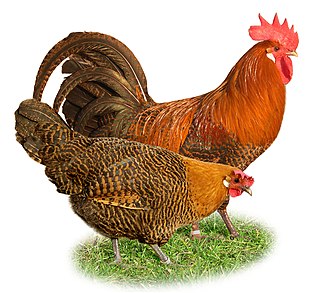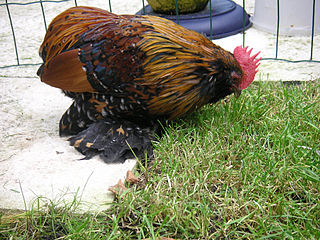Related Research Articles

The Leghorn, Italian: Livorno or Livornese, is a breed of chicken originating in Tuscany, in central Italy. Birds were first exported to North America in 1828 from the Tuscan port city of Livorno, on the western coast of Italy. They were initially called "Italians", but by 1865 the breed was known as "Leghorn", the traditional anglicisation of "Livorno". The breed was introduced to Britain from the United States in 1870. White Leghorns are commonly used as layer chickens in many countries of the world. Other Leghorn varieties are less common.

The Braekel or Brakel is a traditional Belgian breed of chicken. It is thought to have originated in the area of Brakel, in the Flemish province of East Flanders, for which it is named. There is a bantam version of the Braekel. The Campine of the United Kingdom derives from it.

The Cochin is a breed of large domestic chicken. It derives from large feather-legged chickens brought from China to Europe and North America in the 1840s and 1850s. It is reared principally for exhibition. It was formerly known as Cochin-China.

The Pekin Bantam is a British breed of bantam chicken. It derives from birds brought to Europe from China in the nineteenth century, and is named for the city of Peking where it was believed to have originated. It is a true bantam, with no corresponding large fowl. It is recognised only in the United Kingdom, where the Cochin has no recognised bantam version; like the Cochin, it has heavy feathering to the legs and feet. The Entente Européenne treats the Pekin Bantam as equivalent to the bantam Cochin.

The Malay Game is a breed of game chicken. It is among the tallest breeds of chicken, and may stand over 90 cm high.

The Sussex is a British breed of dual-purpose chicken, reared both for its meat and for its eggs. Eight colours are recognised for both standard-sized and bantam fowl. A breed association, the Sussex Breed Club, was organised in 1903.

The New Hampshire Red or New Hampshire is an American breed of chicken. It was developed in the early twentieth century in the state of New Hampshire by selective breeding of Rhode Island Red stock; no other breed was involved. It is fast-growing, early-maturing, quick-feathering, and yields a meaty carcass. Mature birds are a light or medium red in color; they may fade in sunlight.

The Barbu d'Uccle or Belgian d'Uccle, Dutch: Ukkelse Baardkriel, is a Belgian breed of bearded bantam chicken. It was first bred in the town of Uccle on the outskirts of Brussels, in central Belgium, in the early years of the twentieth century. It is a true bantam, with no standard-sized large fowl counterpart, and is one of eleven Belgian true bantam breeds.

The Modern Game is a British breed of ornamental chicken which originated in England between 1850 and 1900. It was bred from gamecock stock, but solely as an exhibition bird.

The Barbu d'Everberg, is a Belgian breed of bantam chicken. It is a tailless variant of the Barbu d'Uccle, and was bred in about 1906 at the Château d'Everberg, at Everberg in the municipality of Kortenberg, between Brussels and Leuven. It is among the most endangered chicken breeds in Belgium, and in 2010 its conservation status was classed as "critical". It is a true bantam, with no large counterpart. Cocks weigh 700–800 grams, and hens 550–650 g.

The Barbu d'Anvers, Dutch: Antwerpse baardkriel, is a breed of bantam chicken from Belgium. It is a true bantam, and has no full-sized counterpart; males weigh about 700 grams and hens about 600 g. The Barbu d'Anvers is one of the oldest bantam breeds, and is thought to have originated in the province of Antwerp in northern Flanders. It is the only Belgian bantam breed not threatened with extinction. In the United States it may be called the Antwerp Belgian or Belgian Bearded d'Anvers.

The Barbu de Watermael, Dutch: Watermaalse Baardkriel, is a Belgian breed of bantam chicken. It originated in the Belgian town of Watermael-Boitsfort, from which it takes its name, which means "bearded [chicken] from Watermael". It is closely related to the Barbu d'Anvers, but is distinguished from it by its small, backswept crest of feathers as well as its triple spiked rosecomb. The Barbu de Boitsfort is a rumpless variation, the only difference being that it lacks the uropygium, the part of the anatomy that carries the tail.
The Belgian Bantam, Dutch: Belgisch kriel, French: Naine belge, is a breed of bantam chicken from Belgium. It is a true bantam, and has no full-sized counterpart; cocks weigh about 650 grams and hens about 550 g. It is in danger of extinction; in 2010 a total of 168 birds were counted in the whole of Belgium. Fourteen colour patterns are recognised in the European standard.

The Ardennaise, French: Poule ardennaise, is a breed of domestic chicken from the Ardennes plateau, in Belgium and eastern France. Its range extends from the Pays de Herve in Wallonia to the French département of Ardennes, and includes the Fagnes, the Famenne, and the valleys of the Amblève, the Ourthe and the Semois.
The Barbu de Boitsfort or Dutch: Bosvoordse Baardkriel is a breed of true bantam from Belgium. It is a tail-less variety of the Barbu de Watermael, and is otherwise similar to it in every respect. It is named for the commune of Watermael-Boitsfort in the Brussels region of Belgium.
The Bassette Liégeoise or Bassette is a breed of large bantam chicken from Belgium. It is larger than most bantams, but much smaller than full-sized breeds; cocks weigh about 1000 grams and hens about 900 g. Like most Belgian bantam breeds, it is in danger of extinction. Eighteen colour patterns are officially recognised; many of them are rare.
The Pictave is an endangered French breed of bantam chicken. It is named for the Pictavi, the tribe which gave its name to the former Province of Poitou, now part of the region of Nouvelle-Aquitaine. It is a true bantam, and has no full-sized counterpart; it is the only true bantam of France. Cocks weigh about 800 grams and hens about 600 g. It was created in the twentieth century by Raymond Lecointre, who used the hens to incubate his pheasant eggs and raise the chicks.

The Niederrheiner is a German breed of chicken. It is named for the Niederrhein or Lower Rhine region where it originated in the early twentieth century, and derives principally from the Dutch North Holland Blue meat chicken. It was recognized in Germany in 1943. In the twenty-first century it is an endangered breed.

The Appenzeller Barthuhn is a Swiss breed of bearded chicken originating in the historical Appenzell region of Switzerland. It is one of two chicken breeds from that area, the other being the Appenzeller Spitzhauben; the only other Swiss breed of chicken is the Schweizer.
References
- ↑ Barbara Rischkowsky, Dafydd Pilling (editors) (2007). List of breeds documented in the Global Databank for Animal Genetic Resources, annex to The State of the World's Animal Genetic Resources for Food and Agriculture. Rome: Commission on Genetic Resources for Food and Agriculture, Food and Agriculture Organization of the United Nations. ISBN 9789251057629. Archived 23 June 2020.
- 1 2 3 4 5 6 7 8 N. Moula, M. Jacquet, A. Verelst, N. Antoine-Moussiaux, F. Farnir, P. Leroy (2012). Les races de poules belges (in French). Annales de Médecine Vétérinaire156: 37-65. Accessed August 2014.
- 1 2 Breed data sheet: Grubbe baardkriel / Belgium (Chicken). Domestic Animal Diversity Information System of the Food and Agriculture Organization of the United Nations. Accessed December 2023.
- 1 2 Victoria Roberts (2008). British poultry standards: complete specifications and judging points of all standardized breeds and varieties of poultry as compiled by the specialist breed clubs and recognised by the Poultry Club of Great Britain. Oxford: Blackwell. ISBN 9781405156424.
- ↑ Liste des races et variétés homologuée dans les pays EE (28.04.2013). Entente Européenne d’Aviculture et de Cuniculture. Archived 16 June 2013.